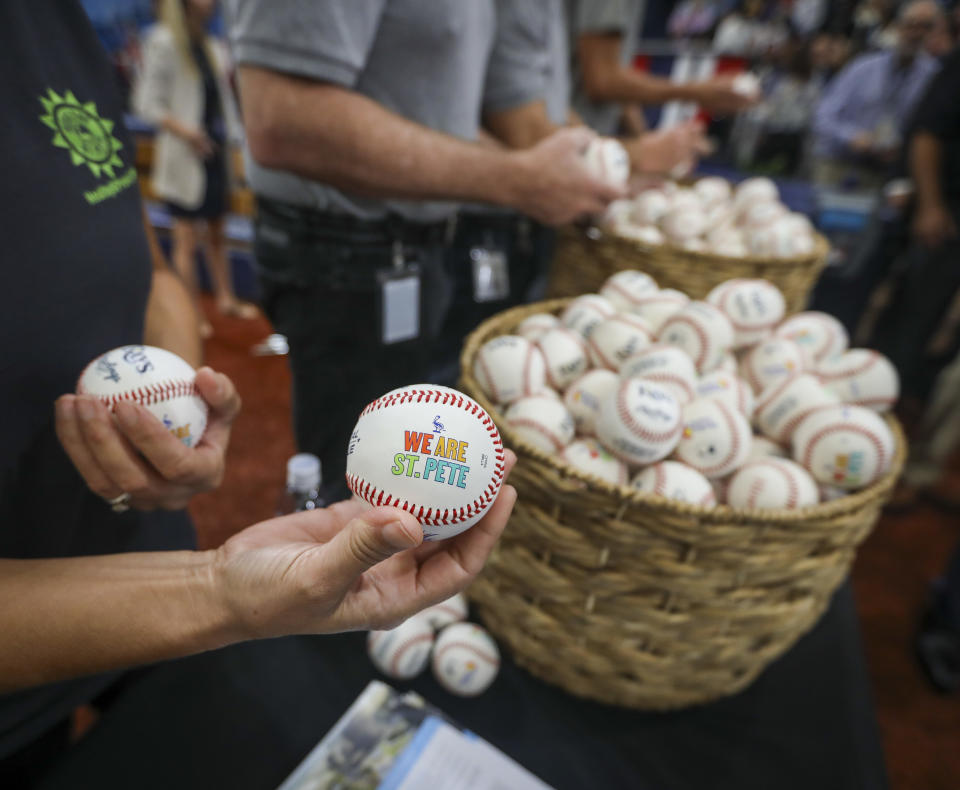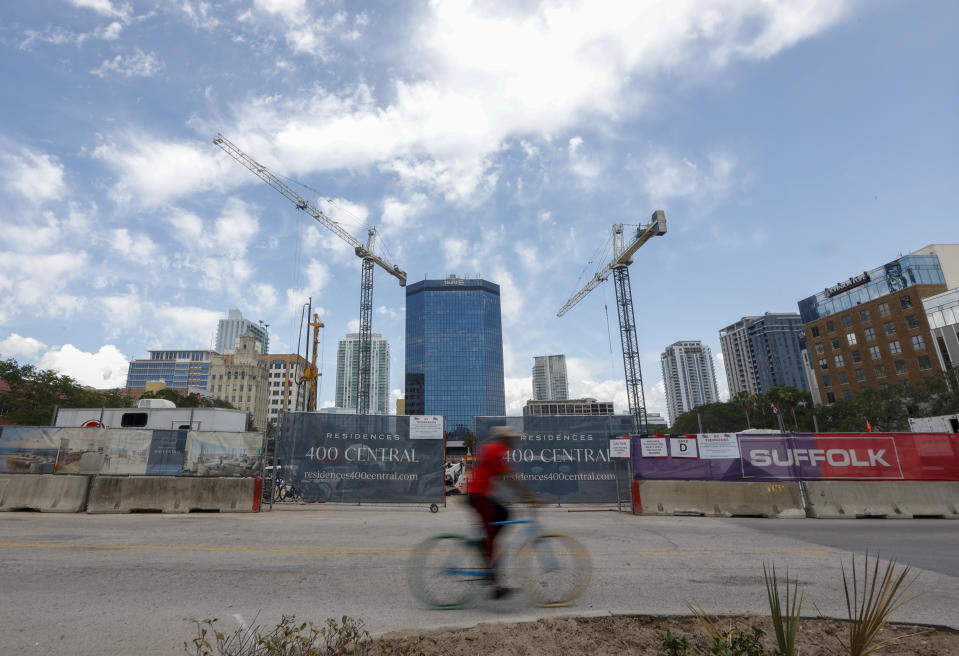For the Rays, St. Petersburg never seemed like the answer. What changed?
- Oops!Something went wrong.Please try again later.
Stuart Sternberg began Tuesday’s news conference at Tropicana Field with a wink to the past.
“I’m here today,” the Rays’ owner said, “to announce a brand-new ballpark on the waterfront with a sail …”
The audience laughed. They knew. The Rays have been down this path before, pitching park after park in spot after spot until finally, some 16 years into their search for a new stadium, striking a deal to stay right where they are.
“2007 is well in the past,” Sternberg said. “We’re up to 2023 now.”
What changed?
There was a time when few, including some with the Rays, thought St. Petersburg would ever be the team’s best option for a long-term home. Smaller than Tampa, and harder to reach from population centers in east Pasco and western Polk counties, it’s still the second-smallest city with a Major League stadium, behind the Atlanta Braves’ ballpark in suburban Cumberland, Georgia.
But as anyone who’s spent time navigating cones and cranes downtown can tell you, St. Petersburg has changed a lot since the team first pitched that sail-topped park on the site of Al Lang Stadium. Back then, the Sundial was still called BayWalk, the Pier was still an upside-down pyramid and the modern Tampa Bay Rowdies didn’t exist. There wasn’t even one craft brewery. Today, the city is an arts and dining destination dotted with new, high-end residential buildings.
“We were talking about a ballpark in St. Petersburg 15 years ago, and we wanted to have that ballpark and the development here at the Trop be something that jump-starts the redevelopment of downtown St. Pete,” Rays co-president Matt Silverman said. “And in those 15 years, St. Petersburg has continued to develop. It’s grown into an even greater place for Major League Baseball. And so now we get the benefit of being a part of the next 30 years of St. Petersburg’s growth, and playing a big role in it.”
As the Rays prepare for their fifth postseason in five years, the team is betting big — $700 million to be exact — that now is the time to go all-in on St. Petersburg, and lead what Pinellas officials say will be the county’s biggest economic development project ever.
“The trajectory of this community is so much greater than it was five years ago, 10 years ago,” Silverman said. “All the different arrows are pointing in the right direction for the city, the county and for Tampa Bay.”
A decade-plus of change
In 2008, the Rays reached their first World Series. It felt like fortuitous timing. Putting a good young team on the field for the first time in franchise history seemed like an ideal way to ramp up stadium negotiations with the city, which was reluctant to let the team explore new sites.
Or so the team thought.
“We believed — maybe naively, as it turned out — that once we started putting postseason appearances together, the attendance issue was going to solve itself,” Rays co-president Brian Auld said in an interview last week. “That obviously wound up not being quite as true as we’d hoped. The 2008 to 2012, 2013 run (of success) that we had is what caused us to have our greatest concerns about St. Petersburg’s ability to support the team on a regular basis.”
The city’s growth was still in the early stages. In 2009, according to the St. Petersburg Downtown Partnership, there were between 3,500 and 4,000 residences in downtown St. Petersburg. By 2015, that number had plateaued around 5,000.
“When folks were trying to convince me that St. Petersburg could be a great home for the Rays for the long haul, they would point to whatever new condo building had gone up and say, ‘Hey, look at that, that’s got to help with attendance,’” Auld said. “I would semi-sarcastically respond, ‘Yep, there’s probably 50 people moving into that building, and if they all come to every single game, our average attendance would go up by 50. And we need to be going up by thousands.’”
Then came a condo boom, emanating from Beach Drive and reaching all the way to the Edge District and Grand Central. Last year, there were more than 8,000 residences downtown, according to the partnership. By 2025, there should be at least 12,000, with an additional 3,000 or so proposed or underway. And that’s not including the first batch of units promised by the Rays and the developer of the Historic Gas Plant District, Hines, by 2026.
“Obviously, when you are thinking about filling a stadium, having a lot of people living in close proximity to a stadium makes that a much easier proposition,” said Jason Mathis, CEO of the St. Petersburg Downtown Partnership. “The demographics of St. Pete have also changed. St. Pete is a younger, more affluent city than it was even 10 years ago, and that trend also seems likely to continue — its number of people, its amount of disposable income.”
St. Petersburg’s median household income and income per capita were higher than Tampa’s in 2022, according to U.S. Census data. St. Petersburg also has a lower unemployment rate and lower rate of people below the poverty rate. It has a higher home ownership rate among Black citizens, and the income disparity between white and Black incomes is smaller.
So far, none of that has necessarily translated into ticket sales. Last year, the team drew 1.13 million fans to home games at Tropicana Field, third worst in the majors. This season, with attendance up across the league, the team was closing in on 1.4 million this weekend — still among baseball’s lowest, and about what it was in 2007, before the team got good. Even so, it’s the Rays’ best home attendance in a decade.
Even if they’re not yet buying tickets, fans are showing greater interest in the team. Game viewership on Bally Sports Sun is up 26% year over year in the Tampa Bay market, according to Nielsen Media Research data provided by Bally. And streaming via the Bally Sports app is up 220% from 2022.
More residents, more fans and more money are an enticing combination, Auld said. New stadiums bring new sponsors and corporate partners and, typically, higher season ticket sales. The Rays might have gotten that bump anywhere. But Auld said the organization is focused on capitalizing on the growth in St. Pete.
“The fact that St. Pete’s population and business trajectory continues to be moving aggressively forward gives us a lot of confidence,” he said. “We’ve never lost sight of the fact that we’re building this ballpark not for tomorrow but for the next 30 years.”
What St. Petersburg will look like then is anyone’s guess. Mathis is sure it won’t look exactly like it does in the Rays’ Trop site proposal, because how can it? The rest of the city is still growing.
“There’s a potential that, 10 years from now, it will be difficult to recognize, unless our community really hones in on the things that matter, like art, culture, local retail and a sense of authenticity,” Mathis said. “We really have to embrace those things that made St. Pete special, so that we don’t lose the soul of this magical place.”
Keeping up with Tampa
Just about everything the Rays have said about St. Petersburg at this moment could also apply to Tampa.
One Hillsborough site recently considered by the Rays, near the spot where Ybor City meets the Channel District, is nestled at the center of a booming stretch for development. On one end is Water Street Tampa, a $3.5 billion destination with 600,000 square feet of office space, 1,300 residences and nearly 1,600 hotel rooms. On the other is the forthcoming Gas Worx, another billion-dollar project with some 5,000 residences, 500,000 square feet of office space and 140,000 square feet of retail.
At a Tampa City Council meeting the day of the stadium announcement, Tampa Sports Authority board member Andy Scaglione, a real estate investor in that area, said the team would regret not planting its flag there.
“I wish the Rays and St. Pete great success,” he said. “As I’ve said in real estate, you pay for a good location once, like Tampa. You pay for an inferior location every day. It costs you the same amount to staff it, costs you the same amount to put the lights on, costs you the same amount to build it. Again, I wish them well, but they made a mistake.”
Auld said Tampa has a lot to offer as a stadium site; it’s why they spent so much time scouting it well up into this summer. The team is still counting on luring some of the fans that would’ve come to Tampa games over to St. Petersburg. More public transportation options, including a widened Howard Frankland Bridge and the Cross Bay Ferry, may help with that.
The Gas Plant District’s rough numbers — 1.4 million square feet of office, 750,000 square feet of retail, and 6,000 residences, hundreds of which will be off-site — are comparable to Water Street and Gas Worx combined. Perhaps more importantly, the Rays don’t have a stake in either of those Tampa developments. In St. Petersburg, they’re partners.
And then there’s the fact that St. Petersburg and Pinellas are preparing to chip in $600 million for the stadium. Public financing in Tampa was less certain.
Take all of that away, though, and there’s still something to St. Pete, said former Ray Matt Joyce, who now works with the team’s Bally Sports broadcast team. Joyce grew up in Tampa and has seen the region evolve firsthand. He pointed to Water Street Tampa as proof that Tampa had the will and resources to encourage major developments, such as a new ballpark.
But, he added, it’s not like St. Petersburg hasn’t kept pace.
“I think it’s just a little different feel, but it’s also a really unique and fun place to really spend your time,” he said. “You see it now, the developments, the buildings, just the unique feel of St. Pete is special.”
For Auld, who’s been with the team since 2005, it’s hard to pinpoint exactly when he first truly saw St. Petersburg as a viable long-term solution. It was just something that’s happened over time, whenever a new tower rose into the skyline near the water, or a new hotel or residential project broke ground in districts adjacent to the Trop.
“Every bit of that is a part of the reason that we’re so excited to fill in the hole in the doughnut here, to build on what the Edge District has already become, to add to what Grand Central is, to connect to Beach Drive and everything wonderful there — and of course to build the right bridges to the South Side communities, too,” he said. “It’s really a unique challenge, but something we think can be absolutely fantastic for the baseball team.”
Times staff writers Joey Knight and Olivia George contributed to this report.



